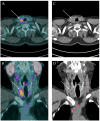PSMA Radioligand Uptake as a Biomarker of Neoangiogenesis in Solid Tumours: Diagnostic or Theragnostic Factor?
- PMID: 36011032
- PMCID: PMC9406909
- DOI: 10.3390/cancers14164039
PSMA Radioligand Uptake as a Biomarker of Neoangiogenesis in Solid Tumours: Diagnostic or Theragnostic Factor?
Abstract
Due to its overexpression on the surface of prostate cancer cells, prostate-specific membrane antigen (PSMA) is a relatively novel effective target for molecular imaging and radioligand therapy (RLT) in prostate cancer. Recent studies reported that PSMA is expressed in the neovasculature of various types of cancer and regulates tumour cell invasion as well as tumour angiogenesis. Several authors explored the role of diagnostic and therapeutic PSMA radioligands in various malignancies. In this narrative review, we describe the current status of the literature on PSMA radioligands' application in solid tumours other than prostate cancer to explore their potential role as diagnostic or therapeutic agents, with particular regard to the relevance of PSMA radioligand uptake as neoangiogenetic biomarker. Hence, a comprehensive review of the literature was performed to find relevant articles on the applications of PSMA radioligands in non-prostate solid tumours. Data on the general, methodological and clinical aspects of all included studies were collected. Forty full-text papers were selected for final review, 8 of which explored PSMA radioligand PET/CT performances in gliomas, 3 in salivary gland malignancies, 6 in thyroid cancer, 2 in breast cancer, 16 in renal cell carcinoma and 5 in hepatocellular carcinoma. In the included studies, PSMA radioligand PET showed promising performance in patients with non-prostate solid tumours. Further studies are needed to better define its potential role in oncological patients management, especially in those undergoing antineoangiogenic therapies, and to assess the efficacy of PSMA-RLT in this clinical context.
Keywords: PET; PSMA; nuclear medicine; radioligand; theragnostics; therapy.
Conflict of interest statement
The authors declare no conflict of interest.
Figures



References
-
- Horoszewicz J.S., Kawinski E., Murphy G.P. Monoclonal antibodies to a new antigenic marker in epithelial prostatic cells and serum of prostatic cancer patients. Anticancer Res. 1987;7:927–935. - PubMed
-
- Israeli R.S., Powell C.T., Fair W.R., Heston W.D. Molecular cloning of a complementary DNA encoding a prostate-specific membrane antigen. Cancer Res. 1993;53:227–230. - PubMed
-
- Silver D.A., Pellicer I., Fair W.R., Heston W.D., Cordon-Cardo C. Prostate-specific membrane antigen expression in normal and malignant human tissues. Clin. Cancer Res. 1997;3:81–85. - PubMed
Publication types
LinkOut - more resources
Full Text Sources
Miscellaneous

